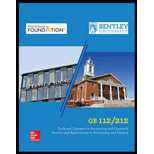
GB 112/212 MANAGERIAL ACC. W/ACCESS >C<
17th Edition
ISBN: 9781260218831
Author: Libby
Publisher: MCG CUSTOM
expand_more
expand_more
format_list_bulleted
Question
Chapter 13, Problem 13.4E
To determine
Match the given companies with its financial information.
Expert Solution & Answer
Want to see the full answer?
Check out a sample textbook solution
Students have asked these similar questions
Accounting problem with correct answer
I am searching for the accurate solution to this general accounting problem with the right approach.
I need help with this general accounting question using the proper accounting approach.
Chapter 13 Solutions
GB 112/212 MANAGERIAL ACC. W/ACCESS >C<
Ch. 13 - Who are the primary users of financial statements?Ch. 13 - When considering an investment in stock, investors...Ch. 13 - How does product differentiation differ from cost...Ch. 13 - What are the two general methods for making...Ch. 13 - What are component percentages? Why are they...Ch. 13 - What is ratio analysis? Why is it useful?Ch. 13 - What do profitability ratios focus on? What is an...Ch. 13 - What do turnover ratios focus on? What is an...Ch. 13 - What do liquidity ratios focus on? What is an...Ch. 13 - What do solvency ratios focus on? What is an...
Ch. 13 - What do market ratios focus on? What is an example...Ch. 13 - Prob. 12QCh. 13 - Explain why rapid growth in total sales might not...Ch. 13 - A company has total assets of 500,000 and...Ch. 13 - Prob. 2MCQCh. 13 - Prob. 3MCQCh. 13 - Prob. 4MCQCh. 13 - Prob. 5MCQCh. 13 - Prob. 6MCQCh. 13 - Prob. 7MCQCh. 13 - Prob. 8MCQCh. 13 - Prob. 9MCQCh. 13 - Prob. 10MCQCh. 13 - Prob. 13.1MECh. 13 - Prob. 13.2MECh. 13 - Prob. 13.3MECh. 13 - Computing the Financial Leverage Percentage...Ch. 13 - Analyzing the Inventory Turnover Ratio A...Ch. 13 - Prob. 13.6MECh. 13 - Prob. 13.7MECh. 13 - Prob. 13.8MECh. 13 - Prob. 13.9MECh. 13 - Prob. 13.10MECh. 13 - Using Financial Information to Identify Companies...Ch. 13 - Prob. 13.2ECh. 13 - Prob. 13.3ECh. 13 - Prob. 13.4ECh. 13 - Prob. 13.5ECh. 13 - Prob. 13.6ECh. 13 - Prob. 13.7ECh. 13 - Prob. 13.8ECh. 13 - Prob. 13.9ECh. 13 - Prob. 13.10ECh. 13 - Inferring Financial Information from Ratios E13-11...Ch. 13 - Prob. 13.12ECh. 13 - Prob. 13.13ECh. 13 - Prob. 13.1PCh. 13 - Prob. 13.2PCh. 13 - Prob. 13.3PCh. 13 - Prob. 13.4PCh. 13 - Prob. 13.5PCh. 13 - Computing Comparative Financial Statements and...Ch. 13 - Analyzing Financial Statements Using Ratios Use...Ch. 13 - Prob. 13.8PCh. 13 - Prob. 13.9PCh. 13 - Prob. 13.1APCh. 13 - Prob. 13.2APCh. 13 - Calculating Profitability, Turnover, Liquidity,...Ch. 13 - Prob. 13.4APCh. 13 - Prob. 13.5APCh. 13 - Prob. 13.6APCh. 13 - Prob. 13.1CPCh. 13 - Prob. 13.2CPCh. 13 - Comparing Companies within an Industry Refer to...Ch. 13 - Prob. 13.4CPCh. 13 - Inferring Information from the DuPont Model Ratios...Ch. 13 - Prob. 13.6CP
Knowledge Booster
Similar questions
arrow_back_ios
SEE MORE QUESTIONS
arrow_forward_ios
Recommended textbooks for you
 College Accounting, Chapters 1-27AccountingISBN:9781337794756Author:HEINTZ, James A.Publisher:Cengage Learning,Principles of Accounting Volume 2AccountingISBN:9781947172609Author:OpenStaxPublisher:OpenStax College
College Accounting, Chapters 1-27AccountingISBN:9781337794756Author:HEINTZ, James A.Publisher:Cengage Learning,Principles of Accounting Volume 2AccountingISBN:9781947172609Author:OpenStaxPublisher:OpenStax College Financial Reporting, Financial Statement Analysis...FinanceISBN:9781285190907Author:James M. Wahlen, Stephen P. Baginski, Mark BradshawPublisher:Cengage Learning
Financial Reporting, Financial Statement Analysis...FinanceISBN:9781285190907Author:James M. Wahlen, Stephen P. Baginski, Mark BradshawPublisher:Cengage Learning Financial And Managerial AccountingAccountingISBN:9781337902663Author:WARREN, Carl S.Publisher:Cengage Learning,
Financial And Managerial AccountingAccountingISBN:9781337902663Author:WARREN, Carl S.Publisher:Cengage Learning,

College Accounting, Chapters 1-27
Accounting
ISBN:9781337794756
Author:HEINTZ, James A.
Publisher:Cengage Learning,


Principles of Accounting Volume 2
Accounting
ISBN:9781947172609
Author:OpenStax
Publisher:OpenStax College


Financial Reporting, Financial Statement Analysis...
Finance
ISBN:9781285190907
Author:James M. Wahlen, Stephen P. Baginski, Mark Bradshaw
Publisher:Cengage Learning

Financial And Managerial Accounting
Accounting
ISBN:9781337902663
Author:WARREN, Carl S.
Publisher:Cengage Learning,